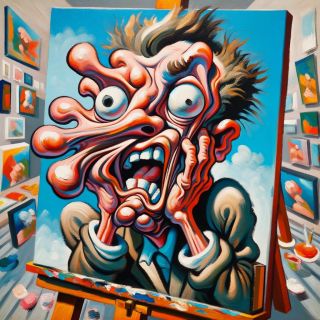Consumer Behavior
Why We Like "Bad Art"
Today, museums of bad art are not uncommon. Why?
Updated March 19, 2024 Reviewed by Michelle Quirk
Key points
- Humans seem to be drawn to bad art. One reason is that it is generally recognizable.
- Another is that our impression of art is likely impacted by our approach to it.
- Lastly, it is in a nuanced way that our brains process and respond to various forms of artistic expression.

Today, museums of "bad art" abound. One of the original was founded in Dedham, Massachusetts. Its subject was interesting enough that it mushroomed to include several branches, including Brookline, South Weymouth, and Somerville. These early museums are closed, and the original museum has relocated to Boston. It is entitled the Museum of Bad Art (MOBA).

Louise Reilly Sacco, Permanent Acting Interim Executive Director of MOBA, provided me with photos of two of the artworks in the collection. She related that the museum does not define “badness.”
Lucy in the Field with Flowers (left), a 30” x 24” oil on canvas painting, was rescued from the trash in Boston, MA. Sacco describes the painting as follows.
The motion, the chair, the sway of her breast, the subtle hues of the sky, the expression on her face; every detail cries out "masterpiece."
This painting was the seed that grew into MOBA.
Another painting, My Left Foot (below left) is a 30”x 36” oil on canvas that was left anonymously at MOBA. Again, a description by Ms. Sacco.

The feet, mismatched in color and shape, are the well-rendered work of a skilled artist. Sooz (the artist) succeeds in getting us to think about the nature of feet and to face our discomfort with asymmetry in any human form. The floor tiles raise questions about our need for orderly surroundings...
Not to be outdone, the Australian continent has one-upped museums of bad art in the United States. It boasts an annual event known as the Museum of Not Just Bad Art" but Particularly Bad Art" (MOPBA), located in Melbourne.
Artwork shown in MOPBA must fit one of the following criteria: (1) There must be a lack of technical skill. (2) It must be devoid of taste. (3) The artist must be uneducated. (4) The viewer must intuitively feel that the artwork is bad.
How would a viewer even know if an artwork is less than it should be? Ellen Winner, author of How Art Works: A Psychological Exploration (2019), researched this question. She investigated whether subjects could differentiate between abstract art executed by skilled artists and that painted by children or, yes, even animals.
Her results indicated that even those unfamiliar with abstract art could recognize works done by expert artists as better compared to those in the other two categories. This suggested to the author that the participants in the study perceived and appreciated the proficiency of the professional artists. This indicates that those uninitiated to art have an inherent feeling about whether an artwork has been executed skillfully.
Others investigated viewers' responses to art under specific circumstances (Gerry Cupchik and colleagues, 2009). The research subjects observed art in an aesthetic versus a pragmatic way while examined with functional magnetic resonance imaging.
The aesthetic approach entailed asking the subjects to evaluate the paintings in a personal manner in order to experience the feelings they evoked. The pragmatic method, on the other hand, involved looking at the paintings objectively (rather than personally) to evaluate the content.
The aesthetic method stimulated the bilateral anterior insula, which is linked to emotion. The pragmatic approach activated the fusiform gyrus, which is known to be active during object identification. Thus, how we approach art (aesthetic or pragmatic) may impact our perception of it, whether good or bad.
In summary, there is a complex interplay of psychological and neurological processes in appreciating art. This challenges the conventional understanding of what constitutes "good" or "bad" art by highlighting the subjective nature of aesthetic experience and the possibility that a pragmatic approach can also affect the viewer’s perception. Simply stated, it is in a nuanced way that our brains process and respond to various forms of artistic expression.
References
Winner, E. (2019). How Art Works: A Psychological Exploration. Oxford University Press.
Cupchik, G. C., Vartanian, O., Crawley, A., & Mikulis, D. J. (2009). Viewing artworks: contributions of cognitive control and perceptual facilitation to aesthetic experience. Brain and Cognition, 70, 84–91. https://doi.org/10.1016/j.bandc.2009.01.003
An inside look at how the Museum of Bad Art is made | ART Inc. on YouTube


